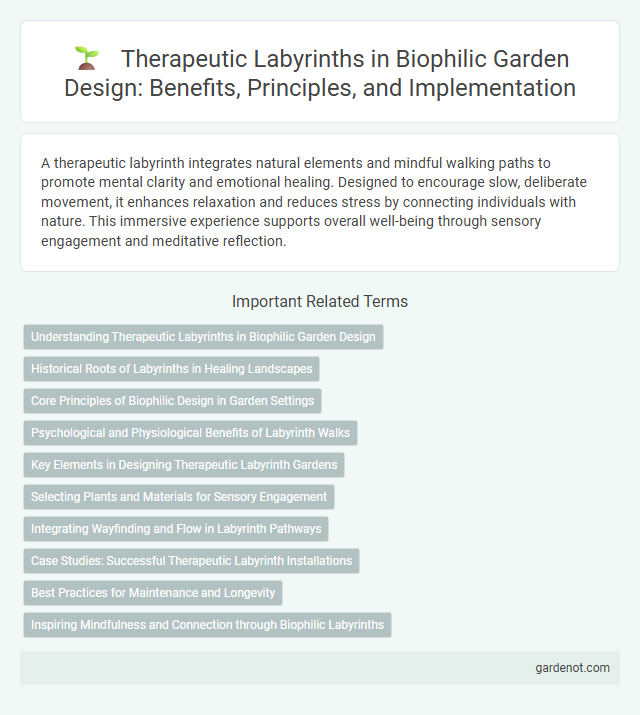A therapeutic labyrinth integrates natural elements and mindful walking paths to promote mental clarity and emotional healing. Designed to encourage slow, deliberate movement, it enhances relaxation and reduces stress by connecting individuals with nature. This immersive experience supports overall well-being through sensory engagement and meditative reflection.
Understanding Therapeutic Labyrinths in Biophilic Garden Design
Therapeutic labyrinths in biophilic garden design serve as meditative pathways that enhance mental well-being by promoting mindfulness and stress reduction through natural engagement. These labyrinths integrate organic patterns and plant life to create immersive experiences that stimulate sensory awareness and emotional healing. Incorporating elements such as curved paths, natural materials, and varied vegetation supports cognitive restoration and fosters a deep connection to nature.
Historical Roots of Labyrinths in Healing Landscapes
Therapeutic labyrinths trace their origins back to ancient healing landscapes where labyrinth designs symbolized spiritual journeys and physical restoration. Historical labyrinths, such as those found in medieval cathedrals like Chartres, were used for meditation and therapeutic walking, promoting mental clarity and emotional well-being. These labyrinths integrated natural elements and symbolic geometry to create immersive environments fostering holistic healing practices.
Core Principles of Biophilic Design in Garden Settings
Therapeutic labyrinths embody core principles of biophilic design by integrating natural elements, fostering multisensory engagement, and promoting restorative experiences in garden settings. These labyrinths utilize organic shapes, natural materials, and ambient sounds to create a seamless connection between users and the natural environment, enhancing mental well-being and reducing stress. Spatial layout emphasizes rhythm and harmony found in nature, encouraging mindful movement and contemplative practices that align with biophilic design's goal of nurturing human-nature relationships.
Psychological and Physiological Benefits of Labyrinth Walks
Therapeutic labyrinths offer proven psychological benefits such as stress reduction, improved focus, and emotional balance through mindful walking. Physiological effects include decreased heart rate and blood pressure, promoting relaxation and enhancing overall cardiovascular health. Labyrinth walks stimulate both hemispheres of the brain, fostering mental clarity and calming the nervous system.
Key Elements in Designing Therapeutic Labyrinth Gardens
Therapeutic labyrinth gardens incorporate winding pathways, central meditative spaces, and natural elements such as native plants and water features to promote mental well-being and stress reduction. Key elements include clear, accessible routes designed for mindfulness walking, sensory stimulation through diverse textures and scents, and integration with surrounding landscapes to create a harmonious environment. These aspects support healing by encouraging reflective practice and connection to nature within healthcare and wellness settings.
Selecting Plants and Materials for Sensory Engagement
Selecting plants and materials for a therapeutic labyrinth prioritizes sensory engagement through diverse textures, colors, and scents that stimulate touch, sight, and smell. Native plants such as lavender, rosemary, and ornamental grasses provide calming fragrances and visual softness, while materials like smooth river stones, natural wood, and textured bark enhance tactile experiences. Integrating these elements fosters mindfulness and stress reduction, optimizing the labyrinth's healing potential through immersive natural interaction.
Integrating Wayfinding and Flow in Labyrinth Pathways
Therapeutic labyrinths enhance biophilic design by incorporating intuitive wayfinding elements that guide users seamlessly through the pathways, promoting mental clarity and relaxation. Strategic use of natural materials, subtle markers, and rhythmic pathway flow fosters a calming sensory experience, encouraging mindfulness and stress reduction. Optimizing labyrinth design for flow continuity supports therapeutic outcomes by balancing cognitive navigation challenges with emotional well-being.
Case Studies: Successful Therapeutic Labyrinth Installations
Therapeutic labyrinth installations have demonstrated significant improvements in mental health across diverse case studies, with facilities like the Cleveland Clinic and the Royal Perth Hospital integrating labyrinths to reduce patient anxiety and enhance mindfulness. Research indicates these designs support neurological healing by promoting calm and focused meditation through intentional walking paths. Data from several healthcare environments reveal decreased stress hormone levels and increased patient satisfaction following labyrinth engagement.
Best Practices for Maintenance and Longevity
Therapeutic labyrinths require regular pruning of native plants and periodic cleaning of stone or mulch paths to prevent overgrowth and erosion, ensuring a safe and accessible environment. Incorporating durable, weather-resistant materials such as natural stone or stabilized decomposed granite enhances structural integrity and longevity. Routine inspections for drainage issues and soil compaction support healthy plant growth and preserve the labyrinth's intended therapeutic function.
Inspiring Mindfulness and Connection through Biophilic Labyrinths
Therapeutic labyrinths designed with biophilic principles harness natural patterns and materials to inspire mindfulness and foster deep connections between individuals and their environment. These labyrinths promote contemplative walking, which enhances mental clarity, reduces stress, and encourages a harmonious relationship with nature. Integrating elements like living plants, natural light, and organic textures amplifies the restorative benefits, making biophilic labyrinths powerful tools for emotional well-being and ecological awareness.
Therapeutic labyrinth Infographic

 gardenot.com
gardenot.com